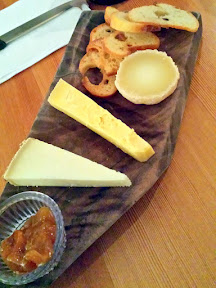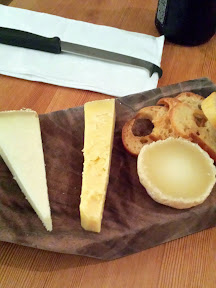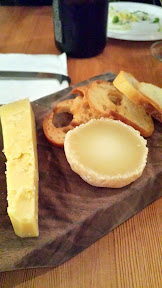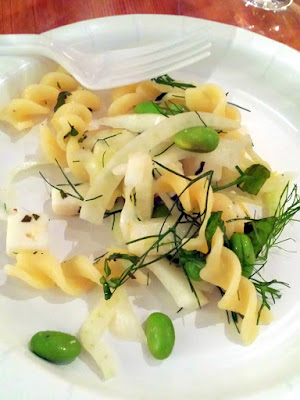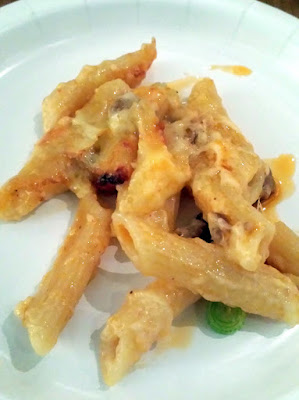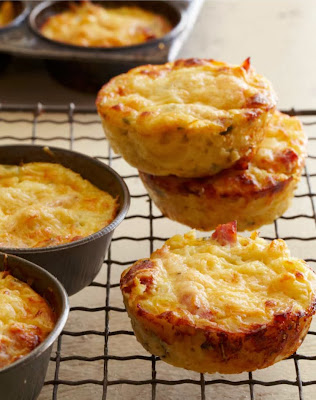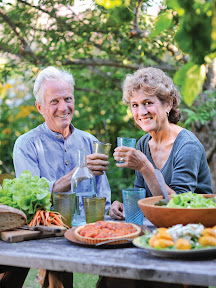So, I totally missed November’s book club assignment! With travel for a wedding, vacation, work travel (and preparing for that work travel), and then Thanksgiving, November really flew by. But I’m back! For December’s book club pick, we were free to read any cookbook we wanted. I decided to write about In the Kitchen with a Good Appetite by Melissa Clark, writer of the food column “A Good Appetite” in the New York Times.
I don’t know if this really counts as a traditional cookbook, though it does offer 150 recipes… so cookbook? Yet, instead of the traditional just all recipes with beautiful photos, the book offers lots of stories. Rather than recipes being the only thing given, there are so many kitchen and eating tales, and the recipe is the natural ending for each food memory essay. Each recipe is preceded with a tale of how it was inspired, and/or how it tastes and how it will transport you to a happy place. Unlike most cookbooks where I browse through looking at titles of recipes, this is one where I remember the story of inspiration or the flavors described and go seeking the matching recipe.

In the Kitchen with a Good Appetite- Photo Credit Con Poulos. I think the cover photo is her Comte Grilled Cheese with Cornichon Spread.
The chapters are short- about 12 chapters covering Breakfast, Vegetables, Fish, Chicken, Other Proteins, Things with Cheese, Sandwiches, Fried Foods, Holiday Food, Desserts, Pie, and Cocktails. Each chapter offers about a dozen recipes, although there are also variations to them added.
Before each recipe are ~2 pages that go into the detail of the experience of making the dish, or the first time she had the dish and how she cobbled together this re-creation. She can never just follow a recipe without tinkering with it based on what she has in her kitchen or because she follows flavors back to origin countries and is inspired to add more- which made this book very much like one of short stories, with each recipe a journey.
That’s a very high level summary- but what really sets Melissa apart is her writing.
I happen to a very visual person and really need photos to make me crave (part of the reason why I started food blogging was to help track the various photos I take of food memories). If you look at all my other cookbooks, they are always full of enviable beautiful food photography. When I first borrowed this book from the library to see what it was like, I was disappointed with the lack of photos. Then I started reading it, and I realized I was only half-way through and bookmarking half the recipes. I needed to just sit and cook from my own well loved, dog eared worn copy of the book.
No photos are ever needed- her detailed, descriptive writing are enough to convince you of the allure of the recipe. Also, there is the way in only 2 recipes she sounds like your best friend who can cook amazing meals and does not hold back on secrets and tips. She is immediately endearing and makes you immediately want to eat what she’s writing about.
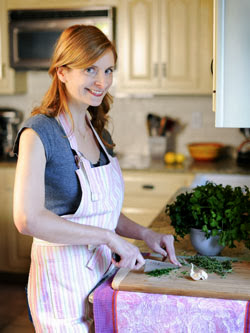
Back cover/author Melissa Clark of In the Kitchen with a Good Appetite, Photo Credit Matthew Benson
I want to be her friend. First, she has a whole chapter devoted to things with cheese. Second, she also says she almost broke up with her husband on their first date when she found out he doesn’t eat cheese… I should admit that in my early 20s, despite being a wonderful friend who supported me and dragged me outside into the world after a breakup, I knew deep in my heart I could never be close friends with a girl because she hated cheese. I still feel guilty for that debt of gratitude for helping me move on but then unceremoniously dropping her out of my life after I recovered. But… cheese (I realize now with vegetarian practically vegan F, karma did get me back- though at least he eats most cheese).
As an example of how Melissa Clark charmed me, she writes about having breakfast for dinner: “One thing about breakfast for dinner is that it’s best made for an intimate number of people, preferably one… Eating cheese-topped scrambled eggs by yourself with the newspaper and a glass of wine will heal all the evils of your day, and you can assemble it in about six minutes flat… As opposed to dinner, breakfast has fewer moving parts to keep track of… it’s nowhere near as complex as mincing garlic, chopping onions and vegetables, and sauteing them all to perfect gold before adding canned tomatoes or fish or what have you. Like stretch jeans and dim lighting, breakfast is forgiving.”
This is then followed by amazing savory breakfast recipes like Buttery Polenta with Parmesan and Olive Oil- Fried Eggs and Swiss Chard, or a Creme Brulee French Toast with Orange Blossom Water, or Baked Flounder with Eggs, or Pesto Scrambled Eggs with Fresh Ricotta (recipe shared below by an adorable Melissa at home in the video. There’s a whole set of videos by Melissa at the New York Times which humorously, plays really whimsical music during the videos). I was soooo hungry reading these, and I’m not even usually a breakfast person (I love dinner most of all).
Each recipe only takes 5 steps or less, and are straightforward. Another ingenious part of this cookbook, besides her warm and inviting writing, is the combination of flavors that also is unique to Melissa and these recipes. She goes Asian with Coconut Fish Strew with Basil and Lemongrass inspired by trying to stretch leftover tom yum soup takeout into another dinner meal. She users one of her favorite pantry items, adobo sauce, to create an almost mole-like flavor in Spiced Chipotle Honey Chicken Breasts with Sweet Potatoes. She mixes up two worlds entirely with a Crispy Tofu with Chorizo and Shiitakes.
She takes Swedish influence from an ex with Max’s Artic Char with Egg Lemon Dragon Sauce, and introduces us to Pan Bagnat (a tuna and vegetable sandwich) from Nice. She shares a secret from an Austrian Chef for perfect light schnitzel by swirling oil as she recounts a recipe for Crisp Chicken Schnitzel with Lemony Spring Herb Salad.
She figures out how to make Lamb Tagine with Apricots, Olive, and Buttered Almonds, but using a deep Dutch oven or cast-iron pot, after combing through 30 recipes for tagine and cherry picking from them all to make the recipe to rule them all, all while never reaching for specialized kitchen equipment, or fancy techniques. Even though in one chapter she mentions she was gifted a stainless steel spaetzle maker, her recipe directions for Homemade Spaetlze with Browned Onions, Swiss chard, and Emmentaler only use a skillet, large bowls, and substitutes the spaetzle maker with a colander.
In trying to make Turkish mock manti, she researched multiple bloggers to come up with Pasta with Turkish-Style Lamb, Eggplant, and Yogurt Sauce to re-create the manti that “as I remembered, the butter ran down the snowy yogurt in thin golden streams, pooling delectably around the pasta. As with the manti, butter and yogurt melded into a rich sauce, generously gilding the lamb, pasta, and in this case, eggplant with garlicky abandon.”
Drooool…
In her sandwich chapter, she references her mother’s sandwich theory of life, which she distills to “While the act of eating, like conversation, is comfort, the content should be an adventure- transporting and exciting, not dull and predictable”
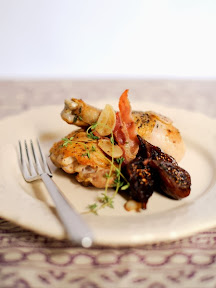
Figgy Piggy Drumsticks and Thigh, from In the Kitchen with a Good Appetite. Photo Credit Matthew Benson
She introduces a whole new level of fried cheese with a Pan Fried Cheese with Anchovy Date Salad. There’s also a recipe for Deep-Fried Bourbon Peach Pies, and also an Un-Pumpkin Pie (Caramelized Butternut Squash Pie with Brandy). Also, she mentions Coconut Hot Chocolate with a Meringue Topping, and Coconut Egg Nog (recipe which she shared on her blog here).
About filling her refrigerator with various jars of condiments, such as nine kinds of mustard, she writes “I’m cultivating a prodigious collection of condiments… this carefully built up inventory (certain to keep us in jalapeño jelly and salted capers for the better part of a nuclear winter)… for someone who cooks a lot, an arsenal of strongly flavored condiments is a powerful secret weapon. Even when there is nothing in the house I can whip up a meal from the contents of many jars mixed with pasta or meat excavated from the freezer. Some of my best culinary feats have come out of such condiment alchemy.”
There are practical tips as well- for an Extra-sharp Leeks Vinaigrette inspired by a dish she had by a friend with a Parisian mustards, she adapts with American supermarket mustard. And she’s very approachable- as in one chapter, she talks about how “Corn on the cob. Butter. Dental floss. It’s an honored summer trinity that I look forward to every year.” and from there is inspired to find a way to eat the kernals without the fibers, producing Brown Buttered Corn that she samples too much of to now serve with dinner for her and her husband, so she turns it into a Broiled Stripe Bass with Brown Butter corn Sauce.
Don’t you wish you were one of her friends that she writes about, such as when she writes (before introducing a dreamy Cheesy Baked Pumpking with Gruyere fondue recipe) that her friend’s sister “Susan is the kind of person who slathers her toast with so much butter you can see it rise up in white waves from the side view.”? I would love to be described so eloquently.
Are you not sold on wanting to own, or at least read this In the Kitchen with a Good Appetite cookbook?
If you are interested in the online book club the Kitchen Reader, the gist of our casual club is there is a new book selected for every month, each book is related to food, and members write a review on their blog during the last week of that month. Except for December which is open-ended, it’s interesting to read the round-up of reviews at the beginning of the month and see what other members have thought! For January the book club selected reading is The Flavor Thesaurus: A Compendium of Pairings, Recipes and Ideas.
Anyway- what’s your favorite cookbook, and why is it your favorite?







